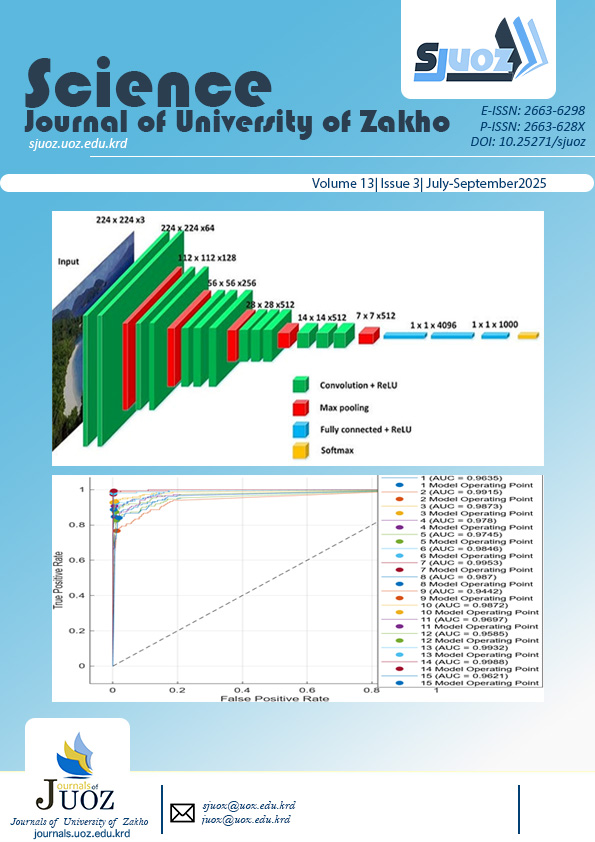DNA BARCODING OF Adansonia digitata USING MULTI-LOCI GENE REGIONS (ITS, rbcL, rpoC1 and psbA-trnH)
DOI:
https://doi.org/10.25271/sjuoz.2025.13.3.1511Keywords:
Adansonia Digitata, BLAST, DNA Barcoding, Phylogeny, PSBA-TRNH, RBCL, Chalcones and its derivatives, NCBI, Multinomial logistic regression model; Odds ratio; categorical data analysis; maximum likelihood method; Binary variable; generalized linear models; classification., Sanger SequencingAbstract
Adansonia digitata, also known as Baobab, is a tree species endemic to Africa. It belongs to the family Malvaceae. The species holds immense economic, cultural, and scientific value worldwide. As a result, it has been introduced to other parts of the world such as India, Sri Lanka, and Australia. Despite its immense value, information on its DNA barcodes for effective identification and conservation efforts of the species is inadequate in the literature. This study aimed to molecularly characterize A. digitata found in Nigerian flora using DNA barcodes from ITS, rbcL, rpoC1, and psbA-trnH primers. DNA was isolated from young leaves, and Sanger sequencing reactions were subsequently performed. Sequences obtained from each primer were subjected to Basic Local Alignment Search Tool (BLAST) analyses conducted on the National Center for Biotechnology Information (NCBI) website. A high percentage similarity range of 98-100% was recorded. Phylogeny was inferred using the Maximum likelihood method with a bootstrap test of 1000 replications. Results revealed a successful species-level identification of A. digitata by rbcL, ITS, and PsbA-trnH primers, as the consensus clustered with identical species with 39%, 88%, and 57% bootstrap support values, respectively. The DNA barcode of A. digitata obtained from the rpoC1 primer submitted to the NCBI nucleotide database with accession number OR251003.1 is the first to be submitted to the database. The accession numbers for the rbcL, ITS, and PsbA-trnH primers are OQ694034, OP709538, and OR135362 respectively. This study provides DNA barcodes for the identification of A. digitata relevant for research, economic, and conservation endeavours.
Downloads
References
Abdulkareem, K.A., Bello, A., Abdul, N., Sidiq, K.O., Olayinka, B.U., Kareem, I., Danzaki, M.M. and Mustapha, O.T. (2024). Phylogenetic analysis of Solanum macrocarpon: the evolutionary relationships and species diversification. Journal of Plant Molecular Breeding 12 (1): 29-37. DOI: 10.22058/JPMB.2024.2031457.1301
Abdulkareem, K.A., Elebiyo, P.T., Olayinka, B.U., Tiamiyu, B.B., Kareem, I., Danzaki, M.M. and Mustapha, O.T. DNA Barcoding of Vernonia amygdalina using ITS and RPOC 1 Multi Loci Gene Regions. Savanna Journal of Basic and Applied Sciences. 5(2) 143-156 https://www.sjbas.com.ng/journal/133812Abdulkareem%20et%20al.pdf
Anakha, M. & Hari, N. (2022). Significance of trnH-psbA marker over matK during barcoding analysis of two Jasminum species in kerala. Life Sciences International Research Journal 8(2), 34-40.
Antil, S., Abraham, J. S., Sripoorna, S., Maurya, S., Dagar, J., Makhija, S., Bhagat, P., Gupta, R., Sood, U., Lal, R., & Toteja, R. (2023). DNA barcoding, an effective tool for species identification: a review. Molecular Biology Reports, 50(1), 761–775. https://doi.org/10.1007/s11033-022-08015-7
Bellary, S., Kyrou, I., Brown, J. E., & Bailey, C. J. (2021). Type 2 diabetes mellitus in older adults: clinical considerations and management. Nature Reviews Endocrinology, 17(9), 534–548. https://doi.org/10.1038/s41574-021-00512-2
Bolson, M., Smidt, E. de C., Brotto, M. L., & Silva-Pereira, V. (2015). ITS and trnH-psbA as Efficient DNA Barcodes to Identify Threatened Commercial Woody Angiosperms from Southern Brazilian Atlantic Rainforests. PLOS ONE, 10(12), e0143049. https://doi.org/10.1371/journal.pone.0143049
Braca, A., Sinisgalli, C., de Leo, M., Muscatello, B., Cioni, P. L., Milella, L., Ostuni, A., Giani, S., & Sanogo, R. (2018). Phytochemical Profile, Antioxidant and Antidiabetic Activities of Adansonia digitata L. (Baobab) from Mali, as a Source of Health-Promoting Compounds. Molecules, 23(12), 3104. https://doi.org/10.3390/molecules23123104
Chen, Q., Hu, H., & Zhang, D. (2022). DNA Barcoding and Phylogenomic Analysis of the Genus Fritillaria in China Based on Complete Chloroplast Genomes. Frontiers in Plant Science, 13. https://doi.org/10.3389/fpls.2022.764255
Dhar, A., & Minin, V. N. (2016). Maximum Likelihood Phylogenetic Inference. In Encyclopedia of Evolutionary Biology (pp. 499–506). Elsevier. https://doi.org/10.1016/B978-0-12-800049-6.00207-9
Donkor, A.M., Addae, D., Kpoanu, J.E., Kankam, F., Boaudi, A.N., and Abanya, E.Y.M. (2014). Antioxidant Enrichment of Baobab Fruit Pulp Treated with Oil extracted from the seeds. Food and Nutrition Sciences, 5(5), 328–333. 10.4236/fns.2014.54039
El-Sherif, N., & Ibrahim, M. (2020). Implications of rbcL and rpoC1 DNA Barcoding in Phylogenetic Relationships of some Egyptian Medicago sativa L. Cultivars. Egyptian Journal of Botany, 60(2), 451-460. https://doi.org/10.21608/ejbo.2020.20028.1399
Eltahir, M.E.S., Elsayed, M.E.O. (2019). Adansonia digitata: Phytochemical Constituents, Bioactive Compounds, Traditional and Medicinal Uses. In: Mariod, A. (eds) Wild Fruits: Composition, Nutritional Value and Products. Springer, Cham. https://doi.org/10.1007/978-3-030-31885-7_11
Gebauer, J., Adam, Y. O., Sanchez, A. C., Darr, D., Eltahir, M. E. S., Fadl, K. E. M., Fernsebner, G., Frei, M., Habte, T.-Y., Hammer, K., Hunsche, M., Johnson, H., Kordofani, M., Krawinkel, M., Kugler, F., Luedeling, E., Mahmoud, T. E., Maina, A., Mithöfer, D., Kehlenbeck, K. (2016). Africa’s wooden elephant: the baobab tree (Adansonia digitata L.) in Sudan and Kenya: a review. Genetic Resources and Crop Evolution, 63(3), 377–399. https://doi.org/10.1007/s10722-015-0360-1
Gostel, M. R., & Kress, W. J. (2022). The Expanding Role of DNA Barcodes: Indispensable Tools for Ecology, Evolution, and Conservation. Diversity, 14(3), 213. https://doi.org/10.3390/d14030213
Hassan, A.H.M. (2023). DNA Barcode of trnH-psbA, A Promising Candidate Gene for Efficient Identification of Bitter and Sweet almond and Related Species. Egyptian J. Desert Res., 73, No. 1, 265-281 available online at DNA Barcode of trnH-psbA
Ibrahima, C., Didier, M., Max, R., Pascal, D., Benjamin, Y. And Renaud, B. (2013). Biochemical and Nutritional Properties of Baobab Pulp from Endemic Species of Madagascar and the African Mainland. African Journal of Agricultural Resesarch. 8(47), 6046–6054.10.5897/ajar12.1231
Jansen, L., Darr, D., Hansohm, N., Gebauer, J., Meinhold, K., Munthali, C., & Wichern, F. (2020). Variation in baobab (Adansonia digitata L.) root tuber development and leaf number among different growth conditions for five provenances in Malawi. Journal of Agriculture and Rural Development in the Tropics and Subtropics (JARTS), 121(2), 161-172. doi:https://doi.org/10.17170/kobra-202007291508
Kaboré, D. (2011). A Review of Baobab (Adansonia digitata) Products: Effect of Processing Techniques, Medicinal Properties and Uses. African Journal of Food Science, 5(16), 833–844.10.5897/AJFSX11.004
Kamatou, G.P., Vermaak, I., and Viljoen, A.M. (2011). An Updated Review of Adansonia digitata: A Commercially Important African Tree. South African Journal of Botany, 77(4), 908–919.10.1016/j.sajb.2011.08.010
Karabanov, D. P., Kotov, A. A., Borovikova, E. A., Kodukhova, Y. V., & Zhang, X. (2023). Comparison of the Efficiency of Single-Locus Species Delimitation Methods: A Case Study of a Single Lake Fish Population in Comparison against the Barcodes from International Databases. Water, 15(10), 1851. https://doi.org/10.3390/w15101851
Larraín, M. A., González, P., Pérez, C., & Araneda, C. (2019). Comparison between single and multi-locus approaches for specimen identification in Mytilus mussels. Scientific Reports, 9(1), 19714. https://doi.org/10.1038/s41598-019-55855-8
Letsiou, S., Madesis, P., Vasdekis, E., Montemurro, C., Grigoriou, M. E., Skavdis, G., Moussis, V., Koutelidakis, A. E., & Tzakos, A. G. (2024). DNA Barcoding as a Plant Identification Method. Applied Sciences, 14(4), 1415. https://doi.org/10.3390/app14041415
Loera-Sánchez, M., Studer, B., & Kölliker, R. (2020). DNA barcode trnH-psbA is a promising candidate for efficient identification of forage legumes and grasses. BMC Research Notes, 13(1), 35. https://doi.org/10.1186/s13104-020-4897-5
Muthai, K. U., Karori, M. S., Muchugi, A., Indieka, A. S., Dembele, C., Mng’omba, S., & Jamnadass, R. (2017). Nutritional variation in baobab (Adansonia digitata L.) fruit pulp and seeds based on Africa geographical regions. Food Science & Nutrition, 5(6), 1116–1129. https://doi.org/10.1002/fsn3.502
Pettigrew, J. D., Bell, K. L., Bhagwandin, A., Grinan, E., Jillani, N., Meyer, J. Wabuyele, E. & Vickers, C. E. (2012). Morphology, ploidy and molecular phylogenetics reveal a new diploid species from Africa in the baobab genus Adansonia (Malvaceae: Bombacoideae). Taxon, 61(6), 1240-1250. 10.1002/tax.616006
Priyanka, G., Gohar, T. and Ginwal, H. (2012). Molecular Characterization of six populations of Acorus calamus L. using random amplified polymorphic DNA (RAPD) markers. African Journal of Biotechnology, 11(40), 9522- 9526. 10.5897/AJB11.1899
Promputtha, I, Jeewon R, Lumyong S, McKenzie, E.H.C, Hyde, K.D. (2005). Ribosomal DNA fingerprinting in the identification of non sporulating endophytes from Magnolia liliifera (Magnoliaceae). Fungal Diversity 20: 167–186.
Rahul, J., Jain, M.K., Singh, S.P., Kamal, R.K., Anuradha, Naz, A., Gupta, A. K., and Mrityunjay, S. K. (2015). Adansonia digitata L. (baobab): A review of traditional information and taxonomic description. Asian Pacific Journal of Tropical Biomedicine, 5(1), 79–84. https://doi.org/10.1016/S2221-1691(15)30174-X
Sarwar, S., Firdous, Q., & Khalid, A. N. (2019). Importance of molecular and phylogenetic analyses for identification of basidiomycetes. In Recent Advances in Phylogenetics. IntechOpen, pp 80. https://doi.org/10.5772/intechopen.80671.
Silva, M. L., Rita, K., Bernardo, M. A., Mesquita, M. F. de, Pintão, A. M., & Moncada, M. (2023). Adansonia digitata L. (Baobab) Bioactive Compounds, Biological Activities, and the Potential Effect on Glycemia: A Narrative Review. Nutrients, 15(9), 2170. https://doi.org/10.3390/nu15092170
Tamura, K. and Nei, M. (1993). Estimation of the number of nucleotide substitutions in the control region of mitochondrial DNA in humans and chimpanzees. Molecular Biology and Evolution, 10, 512-526.10.1093/oxfordjournals.molbev.a040023
Trujillo-Argueta, S., del Castillo, R. F., & Velasco-Murguía, A. (2022). Testing the effectiveness of rbcLa DNA-barcoding for species discrimination in tropical montane cloud forest vascular plants (Oaxaca, Mexico) using BLAST, genetic distance, and tree-based methods. PeerJ, 10, e13771. https://doi.org/10.7717/peerj.13771.
Published
How to Cite
Issue
Section
License
Copyright (c) 2025 Khadijat Abdulkareem Abdulhamid, Yakub Adebare Ajibade, Rashidat Alaba Yusuff , ABDULTOYYIB BELLO, Khalilrahman Olatunji Sidiq, Bolaji Umar Olayinka, Azeez Adebola Lateef , Isiaka Kareem, Mohammed Muazu Danzaki

This work is licensed under a Creative Commons Attribution 4.0 International License.
Authors who publish with this journal agree to the following terms:
- Authors retain copyright and grant the journal right of first publication with the work simultaneously licensed under a Creative Commons Attribution License [CC BY-NC-SA 4.0] that allows others to share the work with an acknowledgment of the work's authorship and initial publication in this journal.
- Authors are able to enter into separate, additional contractual arrangements for the non-exclusive distribution of the journal's published version of the work, with an acknowledgment of its initial publication in this journal.
- Authors are permitted and encouraged to post their work online.








